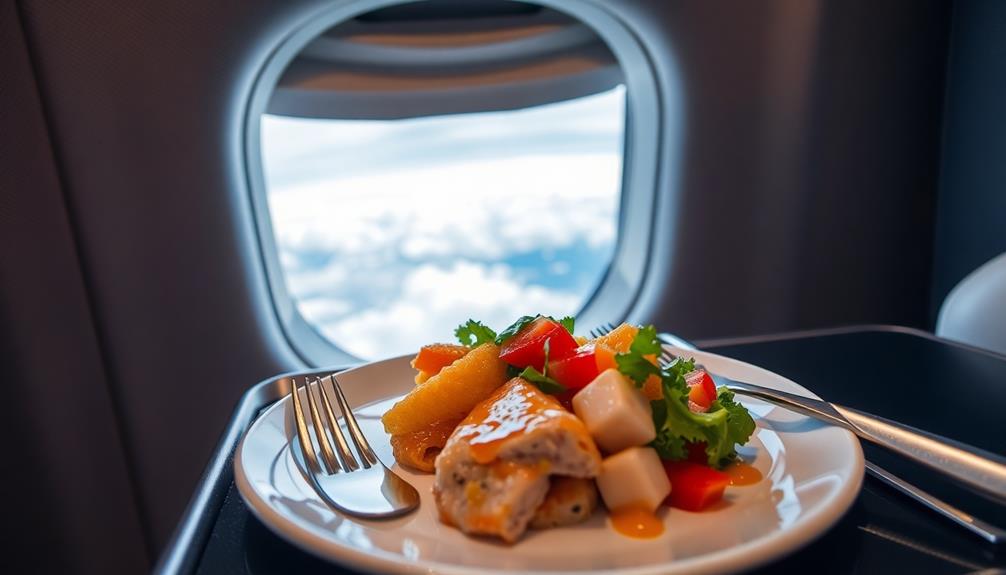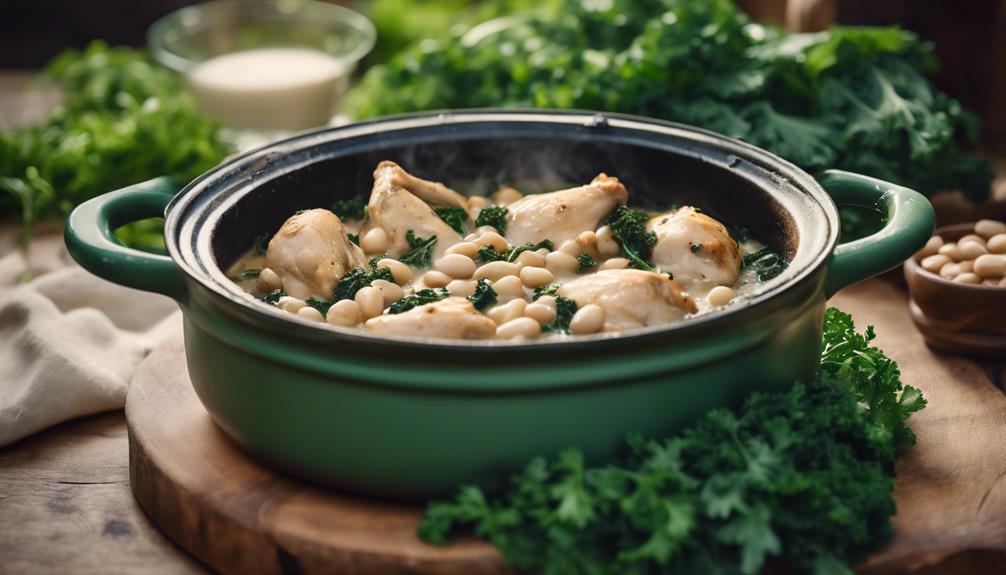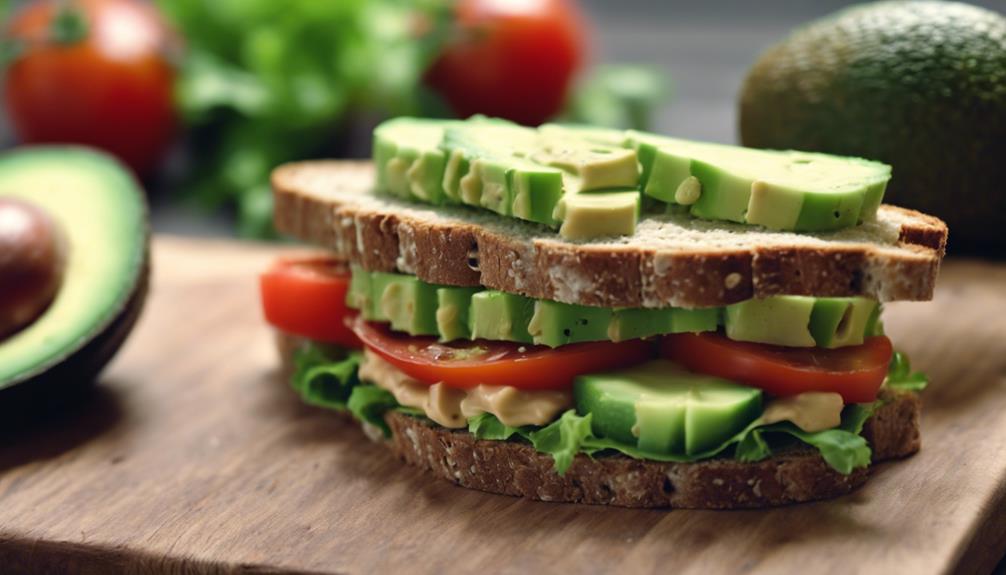Airplane food tastes different mainly because of the high-altitude environment. Low humidity and cabin pressure can dull your ability to taste. In fact, flavors like sweetness and saltiness can be perceived as up to 30% less intense while flying. The loud noise in the cabin further diminishes your taste perception, making meals seem bland. To combat this, airlines use bold flavors and umami-rich ingredients, like mushrooms, to enhance the dining experience. So, if you're curious about what chefs do to improve your meals at cruising altitude, there's plenty more to discover about in-flight dining innovations.
Key Takeaways
- Low humidity in airplane cabins reduces smell, crucial for taste, leading to a diminished flavor experience.
- Cabin pressure at high altitudes decreases taste sensitivity, making meals seem bland.
- Sweetness and saltiness can be perceived as 20-30% less intense while flying.
- Airlines use umami-rich ingredients and bold flavors to enhance in-flight meals.
- Cabin noise levels can further mute the perception of sweet and salty flavors during meals.
Environmental Factors Affecting Taste
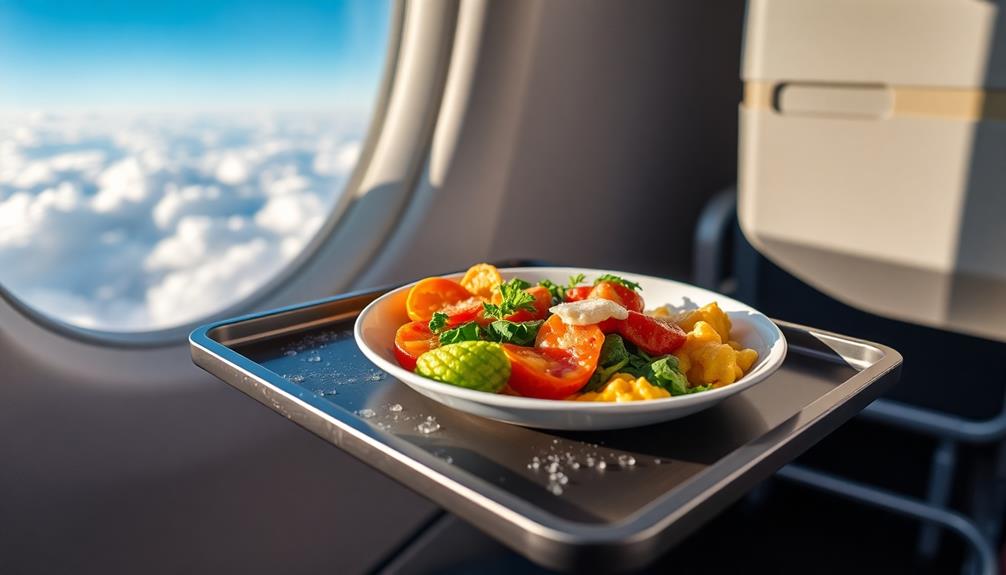
When you're soaring at 30,000 feet, the environmental factors affecting taste can really throw you off. The low humidity in airplane cabins, often dropping below 20%, reduces your taste sensitivity, particularly for sweet and salty flavors.
For instance, dishes like Red-Braised Pork Belly, known for their rich flavor, may not translate well in the air, with those flavors seemingly muted by as much as 30%.
Additionally, the dry air, sometimes as low as 12% humidity, negatively impacts your sense of smell, which is essential for flavor identification. It's estimated that about 80% of what you perceive as taste comes from your sense of smell.
Combine this with the cabin pressure and it's no wonder you're left with a bland dining experience.
Moreover, the noise levels onboard can reach around 85 decibels, further complicating your ability to enjoy your meal. This interference makes foods taste less salty and sweet, while oddly enhancing spices like cardamom.
To combat these challenges, airline chefs often turn to umami-rich ingredients and bolder flavors, crafting meals that stand out amidst the high-altitude environment.
The Science of Taste Sensitivity

At high altitudes, your taste sensitivity takes a hit due to various physiological factors. The low air pressure and dry cabin humidity, which often drops to around 12%, considerably reduce your sense of taste. Research shows that sweetness and saltiness can diminish by about 30%, leaving your food tasting bland.
Since up to 80% of what you perceive as taste comes from your sense of smell, the dry air further compromises your flavor experience. This phenomenon is somewhat similar to how certain traditional dishes in Brazilian cuisine rely on bold flavors to stand out.
Additionally, the noise levels inside the cabin, typically around 85 decibels, can alter your taste perception, making sweet and salty flavors seem even less pronounced. Fortunately, umami flavors remain relatively unaffected by these conditions. This is why airlines often incorporate umami-rich ingredients into their meals to enhance flavor during flights.
Moreover, the combination of dehydration and reduced effectiveness of your taste buds at cruising altitudes means bold spices and flavor enhancements become essential in in-flight meals.
Research Findings on In-Flight Meals
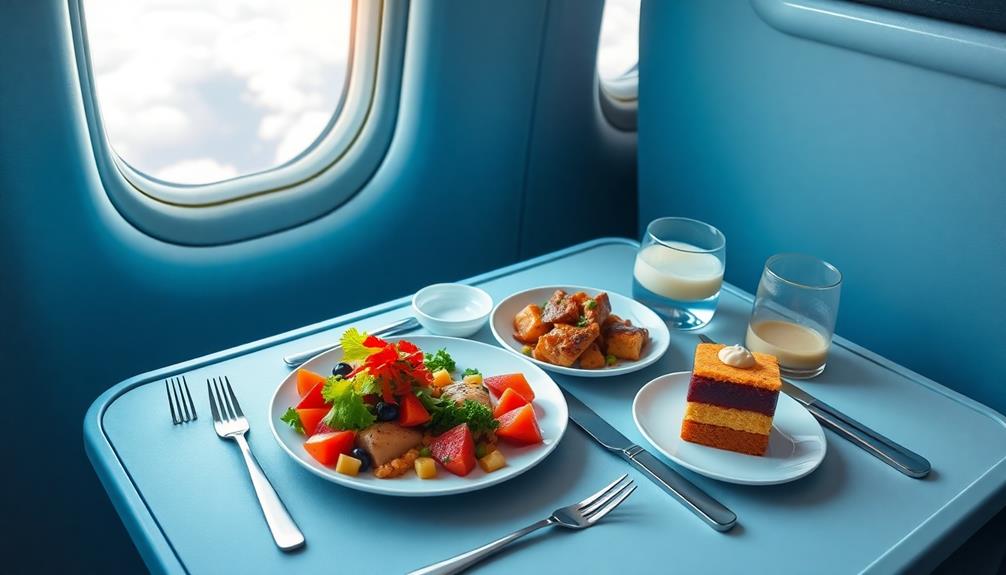
Recent research has revealed intriguing insights into the dining experience at 30,000 feet. At cruising altitude, your taste sensitivity diminishes considerably, with sweetness and saltiness perceived as 30% less intense. This drop in flavor intensity is largely due to low humidity levels, which can plummet to around 12% in the cabin.
Studies highlight that up to 80% of your taste perception relies on smell, which gets compromised in-flight, resulting in airline food that often tastes blander than expected. This phenomenon is similar to how certain dishes, like Nettle and Potato Soup, rely on fresh ingredients to enhance their flavors.
Moreover, environmental factors like high cabin noise levels—hovering around 85db—further diminish your taste sensitivity. This affects how you perceive flavors, making food seem less flavorful overall.
To counteract these challenges, airlines are adapting their meal preparations by enhancing flavors with spices and umami-rich ingredients, as research in Experimental Psychology suggests that umami flavors hold up better at altitude.
Ongoing research on in-flight meals aims to optimize your dining experience by testing meals in pressurized environments. These findings not only shed light on why airplane food tastes different but also pave the way for more flavorful meals at cruising altitude.
Airline Meal Preparation Techniques
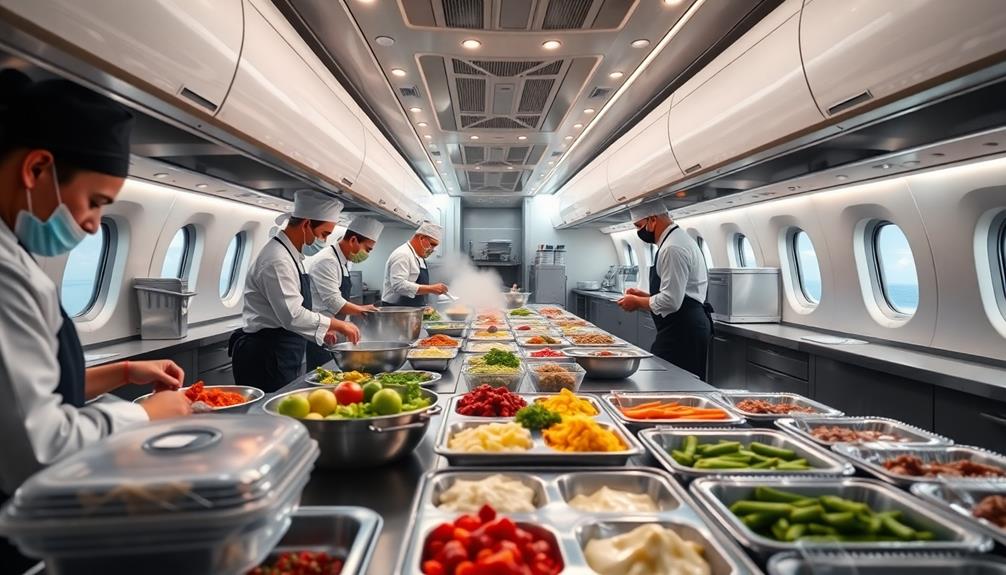
When it comes to airline meal preparation, chefs make specific adjustments to recipes for high-altitude dining.
They often draw inspiration from culinary traditions from around the world, incorporating bold flavors that can stand out in the unique environment of a plane.
Using advanced cooking techniques like sous-vide, they guarantee your meal retains its intended taste even after reheating.
Recipe Adjustments for Altitude
To guarantee a satisfying in-flight dining experience, airlines make specific recipe adjustments for altitude that enhance flavor and appeal. At cruising altitudes, your taste buds can experience up to a 30% reduction in sensitivity due to low pressure and dry air.
To combat this, airlines carefully select ingredients that pack a punch, particularly those rich in umami, like mushrooms and hard cheeses. Traditional Japanese dishes, such as Dorayaki (Red Bean Pancake), also rely on rich flavors that could translate well to airline meals. These ingredients not only improve the overall taste of meals but also hold up better in the unique conditions of the sky.
Most meals are cooked on the ground using methods like sous-vide, which helps retain moisture and flavor before they're reheated in convection ovens during the flight. Airlines also conduct tests in pressurized environments to guarantee that the dishes maintain their intended flavor profiles at altitude.
Continuous feedback from passengers plays a vital role in refining menu offerings, focusing on bold and robust flavors. By making these recipe adjustments, airlines aim to create a more enjoyable dining experience, transforming airplane meals into something that can be savored, even at 30,000 feet.
Cooking Techniques for Flights
Cooking techniques for airline meals are designed to guarantee that every bite remains flavorful and enjoyable, even at cruising altitude. Most in-flight meals are cooked on the ground and reheated in convection ovens during the flight, as microwaves aren't allowed for safety reasons. This process can alter the intended flavor profiles, but airlines are increasingly adopting sous-vide cooking techniques. This method enhances flavor retention and assures food quality at high altitudes.
For instance, dishes like Mushroom Masala and Chicken Chettinad exemplify how rich flavor profiles can be preserved through careful preparation methods.
To tackle the challenge of diminished taste sensitivity due to the lack of humidity in the cabin, airlines collaborate with catering providers to incorporate umami-rich ingredients and bold flavors. They even test meals in pressurized environments, simulating in-flight conditions, allowing chefs to adapt their recipes for better outcomes.
Moreover, creative solutions like using heavier cutlery and optimizing meal presentation help enhance the dining experience. By addressing the unique challenges posed by flying, these cooking techniques assure that your taste buds are treated to sweet, savory, and satisfying flavors, making your meal memorable, even at 30,000 feet.
Unique Dining Experiences at Altitude
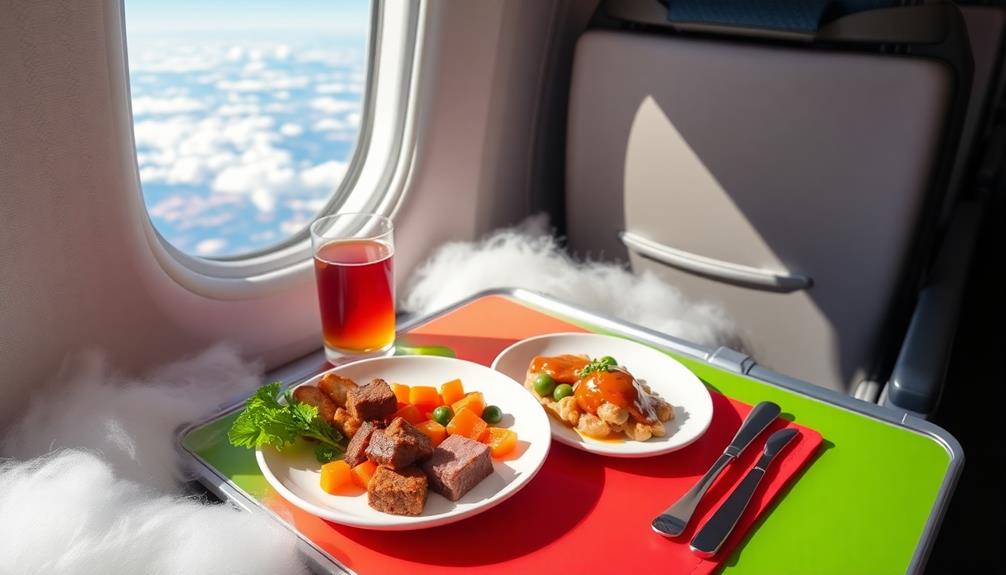
When you're soaring at 30,000 feet, the environment can really change how your food tastes.
With reduced humidity and cabin noise, flavors can seem muted, prompting airlines to get creative with bold ingredients.
For instance, dishes inspired by Thai street food, such as spicy sausages or sweet desserts, can provide a burst of flavor that stands out in the air.
You'll find that innovative culinary adaptations are key to ensuring your in-flight meal is both tasty and memorable.
Environmental Influence on Flavor
Experiencing the unique flavors of airplane food is influenced markedly by the environmental conditions at cruising altitude. At around 30,000 feet, several factors come into play that alter your taste perception, much like how traditional dishes such as Muamba De Galinha bring rich flavors to the table through their unique ingredients.
- Low Air Pressure: The cabin's low air pressure reduces your sensitivity to sweetness and saltiness by 20-30%.
- Impaired Sense of Smell: With cabin humidity levels dropping below 12%, your sense of smell suffers, responsible for up to 80% of taste perception, making meals taste bland.
- Noise Levels: At about 85 decibels, the noise in the cabin can further diminish flavor, making your food seem less enjoyable.
Interestingly, while many flavors lose intensity, umami flavors, like those found in tomato juice, stand out more at altitude.
Airlines have adapted to this by focusing on robust, umami-rich ingredients to enhance your in-flight dining experience.
Innovative Culinary Adaptations
The challenges of dining at 30,000 feet have sparked a wave of innovative culinary adaptations designed to elevate your in-flight experience. Airlines are increasingly collaborating with gourmet chefs to create specialized menus that enhance flavor profiles suited for high-altitude dining.
Research shows that our taste perception, particularly of saltiness, diminishes while flying, prompting airlines to prioritize umami-rich ingredients like mushrooms and hard cheeses in their meals. This consideration mirrors the careful balance of flavors found in traditional Korean dishes, such as bulgogi, where marinated beef is enhanced through a rich soy sauce blend.
To further improve your experience, some airlines have started using heavier cutlery instead of lightweight plastic. This simple change can surprisingly enhance the perception of food flavors during your flight.
Additionally, British Airways is experimenting with soundtracks designed to complement in-flight meals, using music to evoke flavors and elevate your overall dining experience.
Aromatic elements incorporated into meal presentations also play a significant role. These sensory enhancements improve the olfactory experience, making your food and drinks more enjoyable.
With these innovative approaches, airlines aren't just serving meals; they're curating unique dining experiences that transform the way you savor food at altitude.
Innovations in Food and Drink

Airlines are shaking up in-flight dining by embracing innovative approaches that cater to our taste buds at high altitudes.
They're collaborating with local food producers and chefs to create meals that maintain flavor, even when cruising thousands of feet above the ground. Just as creative as the Graveyard Taco Dip for Halloween gatherings, these airline meals are designed to be memorable and enjoyable.
Here are three exciting innovations you can expect:
- Umami-Rich Ingredients: Airlines are using ingredients like mushrooms and seaweed to enhance airplane food tastes, combating the common blandness of in-flight meals.
- Sensory Experiences: Some carriers have introduced soundtracks to elevate your dining experience. With noise-cancelling headphones, music is paired with food to evoke stronger flavor perceptions.
- Innovative Beverage Options: Expect custom craft beers from local breweries, designed specifically to maintain flavor despite altitude effects.
These advancements focus on flavor enhancement, ensuring that your meals are as enjoyable as possible.
By prioritizing unique ingredients and sensory experiences, airlines are transforming in-flight dining into a more satisfying affair.
Next time you fly, you might just find that your meal tastes considerably better, all thanks to these creative approaches in the sky!
Tips for Enjoying Airplane Meals

To fully enjoy your in-flight meal, it's essential to be mindful of a few key tips that can greatly enhance your dining experience.
First, stay hydrated before and during your flight. The low cabin humidity can impair your taste perception, so drinking plenty of water will help you appreciate the flavors in your meals.
When it comes to meals, consider requesting special options like vegetarian or low-fat choices, as these are often fresher and more flavorful.
It's also wise to eat early in the flight; food loses warmth and freshness the longer it sits on food carts.
For snacks, go for flavorful options like nuts, spicy foods, or high-umami items such as cheese and tomatoes, which retain their taste better at altitude.
Additionally, bring along personal favorite snacks that are less affected by the environment, like dried fruits or sturdy granola bars, to supplement your meal and enhance your in-flight dining experience.
Frequently Asked Questions
Why Does Food Taste Different When Flying?
When you fly, changes in cabin pressure, humidity, and noise impact your taste buds. You might notice flavors seeming less intense, making your meal taste different than it would on the ground.
How to Make Airplane Food Taste Better?
To make airplane food taste better, stay hydrated, request special meals, and bring your own flavorful snacks. Consider packing umami-rich treats or spices to enhance your in-flight dining experience considerably. Enjoy your journey!
Why Does Food Taste Different at Altitude?
At 30,000 feet, your taste buds become muted, like a whisper in a storm. The dry air and cabin noise dull sweetness and saltiness, leaving you craving bolder flavors that fight the altitude's culinary challenges.
How Is Airline Food Different?
Airline food's different because it's mass-produced, often reheated, and designed for high altitude. You'll notice bolder flavors, especially umami, to compensate for diminished taste perception, creating a unique dining experience while flying.
Conclusion
To sum up, airplane food tastes different due to a blend of environmental factors, taste sensitivity, and unique preparation techniques. For instance, a study by the University of Gastronomic Sciences found that cabin pressure and humidity can dull your taste buds, making flavors less vibrant. So, next time you're cruising at 30,000 feet, remember that your palate is affected by the altitude. Embrace the experience and savor the meal, even if it doesn't quite match your expectations!
